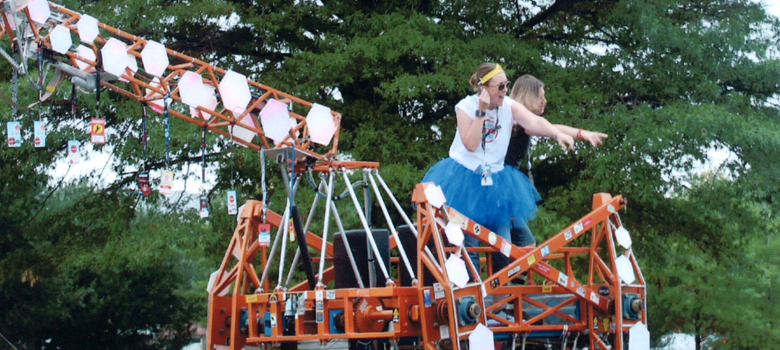
The Fifth Annual World Maker Faire was held this year at the site of the 1939 and 1964 World’s Fairs in Flushing, Corona Park, N.Y. I attended as part of a group sponsored by the IEEE.
The Maker Faire is a concept of Dale Dougherty, who is also the publisher of the DIY magazine, MAKE. The first Maker Faire was held in 2006, and 100 were held worldwide in 2013. Today, most are independently organized by communities, museums, and libraries, and licensed by Maker Faire. Each event is a carnival-like demonstration of innovation and creativity by participants of all ages and at all levels of complexity, and often helps inspire hands-on STEM programs in local school systems. Participants can be individuals, groups, or associations.
This year’s two-day World Maker Faire was held at the New York Hall of Science (built as part of the 1964 World’s Fair) and on the grounds of the adjoining Space Park, with some 600 exhibitor/makers participating. Intel, Radio Shack, LEGO, Disney, Texas Instruments, Toyota, Ford, Microsoft, and Meccano were among the more than thirty corporate sponsors.
I found it impossible to visit all of the exhibits and events that I hoped to see. Here are just a few.
- Soon after the gates, opened a crowd gathered around a 1984 Volvo. It was not easy to determine the make and model as the exterior was covered with catfish, bass, trout, and lobsters. And they were singing (yes, the fish and lobsters!) a classical Italian opera. At appropriate points a lobster would arise from among the lobster chorus arranged on the hood to belt out a solo. In all, some 250 computer-controlled singing and dancing fish, collectively titled the Sashimi Tabernacle Choir, were led by an energetic lobster conductor. Richard Carter and John Schroeter began the project in 2001 and have upgraded it several times since. Six different bracket designs were used to mount the modified Billy Bass, which were disassembled and rewired. Some five miles of wire lead to the trunk, which houses computers plus batteries for both the stereo and the performing fish. By 2003, Billy Bass Superstar had become available. A pair of them were purchased and reworked to produce a male and a female soloist, each under separate computer control, who can now rise, wiggle, and sing from the roof of the Volvo.
- The Puppet Phactory was my next stop. Here kid-friendly toys were made from junkable items-disposable electronics, bicycle and vacuum cleaner parts, for example.
- Next came the Tick Tock Croc, a several-yards-long articulated crocodile propelled by bicycles hidden within.
- In another display, artists exploited e-waste to produce artwork, including a large sculpture of Manhattan Island.
- Experts at the Fix-It Village provided demonstrations on how to fix various electronic products.
- Adults and kids alike were busy learning how to solder in the Radio Shack section of the Maker Shed.
- The 3D Printer Village showed off the work of several entrepreneurs, including a life-size printed robot. The “Strati,” a drivable 3D printed car built by Local Motors with the aid of Oak Ridge National Laboratories, was on display. Parts of its carbon-fiber hood and interior had been “subtractively machined.” Its total time to print was given as 44 hours.
- · At the entrance to the Hall of Science, youngsters were invited to frolic on a large illuminated grid designed by Willow Glen Makers of San Jose. Depending on where the kids stepped, the grid’s colors and patterns would change accordingly. An operator could switch to alternate circuitry to provide surprising new patterns, and was prepared to discuss the circuitry with interested adults.
Speaker Program
Among several speakers during the event were Herb Deutsch, co-inventor of the Moog Synthesizer; James Adam, director of engineering at Raspberry Pi; and David Miller, NASA’s chief technologist. I sat in on a session led by Chris Peterson, assistant director of admissions at MIT, who described a new program at MIT in which students seeking admittance are invited to submit a report on a “maker” project they have undertaken and completed. Whereas fewer than 8 percent of those applying to MIT are accepted, in the case of those submitting maker reports, over 11 percent are accepted. Peterson reported with some disappointment that only 15 percent of the maker project reports were submitted by females, although the percentage of female students at MIT is far greater.
As closing time neared, I hurried to view the power race track, a life-size mousetrap, a game of drones, the circus warehouse, and robot row. I vowed to plan my agenda more carefully next year!
Meanwhile, if you attended this Maker Faire (or others) as a participant-maker or as a visitor, your comments are welcome.
Resources
- Hall of Science-1964 World’s Fair https://www.westland.net/ny64fair/map-docs/hallscience.htm (retrieved 9-26-14)
- The Year of 100 Maker Faires https://makezine.com/2014/01/01/the-year-of-100-maker-faires/ (retrieved 9-27-14)
- Lynch, T.W., “The Maker Movement Makes Its Mark” https://www.usatoday.com/story/tech/2014/08/04/the-maker-movement-makes-its-mark/13567521/ (retrieved 9-30-14)
- Barajarin, T., “Why The Maker Movement Is Important to America’s Future” https://time.com/104210/maker-faire-maker-movement/ (retrieved 9-30-14)
and an independent publishing consultant. He is a Fellow of the IEEE. You can write to him at
donchristiansen@ieee.org.






